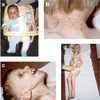Cockayne syndrome and xeroderma pigmentosum
- PMID: 11185579
- PMCID: PMC4459578
- DOI: 10.1212/wnl.55.10.1442
Cockayne syndrome and xeroderma pigmentosum
Abstract
Objectives: To review genetic variants of Cockayne syndrome (CS) and xeroderma pigmentosum (XP), autosomal recessive disorders of DNA repair that affect the nervous system, and to illustrate them by the first case of xeroderma pigmentosum-Cockayne syndrome (XP-CS) complex to undergo neuropathologic examination.
Methods: Published reports of clinical, pathologic, and molecular studies of CS, XP neurologic disease, and the XP-CS complex were reviewed, and a ninth case of XP-CS is summarized.
Results: CS is a multisystem disorder that causes both profound growth failure of the soma and brain and progressive cachexia, retinal, cochlear, and neurologic degeneration, with a leukodystrophy and demyelinating neuropathy without an increase in cancer. XP presents as extreme photosensitivity of the skin and eyes with a 1000-fold increased frequency of cutaneous basal and squamous cell carcinomas and melanomas and a small increase in nervous system neoplasms. Some 20% of patients with XP incur progressive degeneration of previously normally developed neurons resulting in cortical, basal ganglia, cerebellar, and spinal atrophy, cochlear degeneration, and a mixed distal axonal neuropathy. Cultured cells from patients with CS or XP are hypersensitive to killing by ultraviolet (UV) radiation. Both CS and most XP cells have defective DNA nucleotide excision repair of actively transcribing genes; in addition, XP cells have defective repair of the global genome. There are two complementation groups in CS and seven in XP. Patients with the XP-CS complex fall into three XP complementation groups. Despite their XP genotype, six of nine individuals with the XP-CS complex, including the boy we followed up to his death at age 6, had the typical clinically and pathologically severe CS phenotype. Cultured skin and blood cells had extreme sensitivity to killing by UV radiation, DNA repair was severely deficient, post-UV unscheduled DNA synthesis was reduced to less than 5%, and post-UV plasmid mutation frequency was increased.
Conclusions: The paradoxical lack of parallelism of phenotype to genotype is unexplained in these disorders. Perhaps diverse mutations responsible for UV sensitivity and deficient DNA repair may also produce profound failure of brain and somatic growth, progressive cachexia and premature aging, and tissue-selective neurologic deterioration by their roles in regulation of transcription and repair of endogenous oxidative DNA damage.
Figures


Similar articles
-
DNA repair and ultraviolet mutagenesis in cells from a new patient with xeroderma pigmentosum group G and cockayne syndrome resemble xeroderma pigmentosum cells.J Invest Dermatol. 1996 Oct;107(4):647-53. doi: 10.1111/1523-1747.ep12584287. J Invest Dermatol. 1996. PMID: 8823375
-
Elevated Urinary Levels of 8-Hydroxy-2'-deoxyguanosine in a Japanese Child of Xeroderma Pigmentosum/Cockayne Syndrome Complex with Infantile Onset of Nephrotic Syndrome.Tohoku J Exp Med. 2016 Jul;239(3):231-5. doi: 10.1620/tjem.239.231. Tohoku J Exp Med. 2016. PMID: 27396511
-
Cerebro-oculo-facio-skeletal syndrome with a nucleotide excision-repair defect and a mutated XPD gene, with prenatal diagnosis in a triplet pregnancy.Am J Hum Genet. 2001 Aug;69(2):291-300. doi: 10.1086/321295. Epub 2001 Jul 3. Am J Hum Genet. 2001. PMID: 11443545 Free PMC article.
-
Xeroderma pigmentosum, trichothiodystrophy and Cockayne syndrome: a complex genotype-phenotype relationship.Neuroscience. 2007 Apr 14;145(4):1388-96. doi: 10.1016/j.neuroscience.2006.12.020. Epub 2007 Feb 1. Neuroscience. 2007. PMID: 17276014 Free PMC article. Review.
-
Xeroderma pigmentosum and related disorders: defects in DNA repair and transcription.Adv Genet. 2001;43:71-102. doi: 10.1016/s0065-2660(01)43004-5. Adv Genet. 2001. PMID: 11037299 Review.
Cited by
-
A Japanese girl with mild xeroderma pigmentosum group D neurological disease diagnosed using whole-exome sequencing.Hum Genome Var. 2020 Aug 7;7:22. doi: 10.1038/s41439-020-0109-z. eCollection 2020. Hum Genome Var. 2020. PMID: 32802388 Free PMC article.
-
The XPA Protein-Life under Precise Control.Cells. 2022 Nov 22;11(23):3723. doi: 10.3390/cells11233723. Cells. 2022. PMID: 36496984 Free PMC article. Review.
-
Construction and purification of site-specifically modified DNA templates for transcription assays.Nucleic Acids Res. 2003 Apr 1;31(7):e40. doi: 10.1093/nar/gng040. Nucleic Acids Res. 2003. PMID: 12655028 Free PMC article.
-
Different effects of CSA and CSB deficiency on sensitivity to oxidative DNA damage.Mol Cell Biol. 2004 Sep;24(18):7941-8. doi: 10.1128/MCB.24.18.7941-7948.2004. Mol Cell Biol. 2004. PMID: 15340056 Free PMC article.
-
BRCA1 contributes to transcription-coupled repair of DNA damage through polyubiquitination and degradation of Cockayne syndrome B protein.Cancer Sci. 2011 Oct;102(10):1840-7. doi: 10.1111/j.1349-7006.2011.02037.x. Epub 2011 Aug 18. Cancer Sci. 2011. PMID: 21756275 Free PMC article.
References
-
- Cockayne EA. Dwarfism with retinal atrophy and deafness. Arch Dis Child. 1936;21:52–54. - PubMed
-
- Cleaver JE, Thompson LH, Richardson AS, States JC. A summary of mutations in the UV-sensitive disorders: xeroderma pigmentosum, Cockayne syndrome, and trichothiodystrophy. Hum Mutat. 1999;14:9–22. - PubMed
-
- Robbins JH, Kraemer KH, Lutzner MA, Festoff BW, Coon HG. Xeroderma pigmentosum. An inherited disease with sun sensitivity, multiple cutaneous neoplasms, and abnormal DNA Repair. Ann Intern Med. 1974;80:221–248. - PubMed
-
- Robbins JH. Xeroderma pigmentosum. Defective DNA repair causes skin cancer and neurodegeneration. JAMA. 1988;260:384–388. - PubMed
-
- Nance MA, Berry SA. Cockayne syndrome: review of 140 cases. Am J Med Genet. 1992;42:68–84. - PubMed
Publication types
MeSH terms
Grants and funding
LinkOut - more resources
Full Text Sources
Molecular Biology Databases
